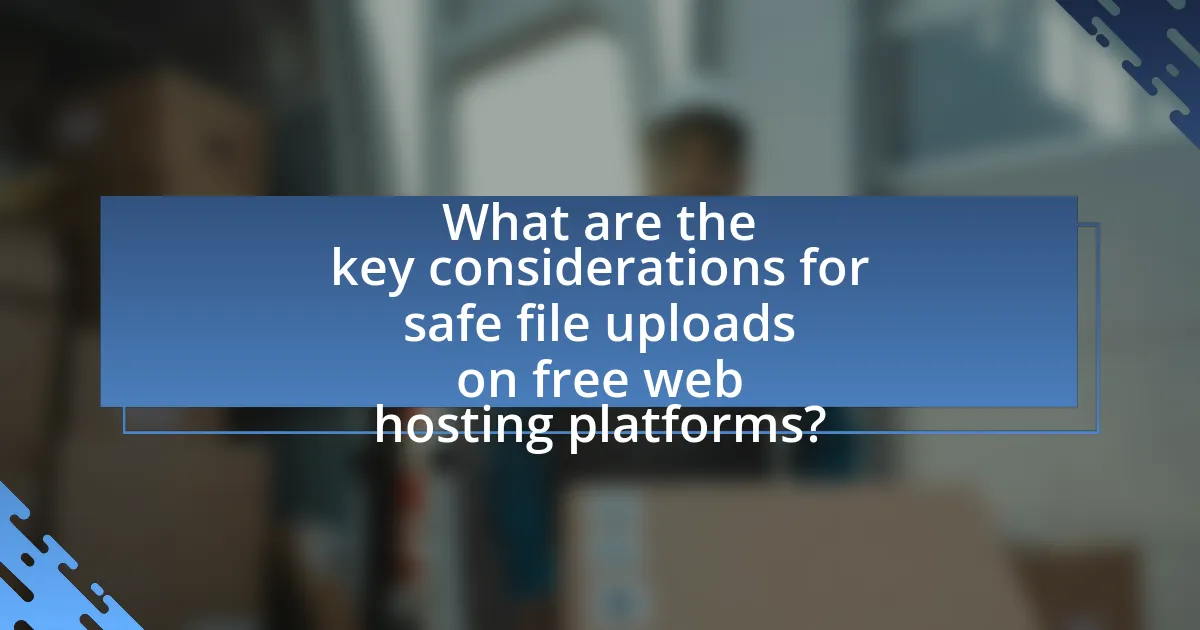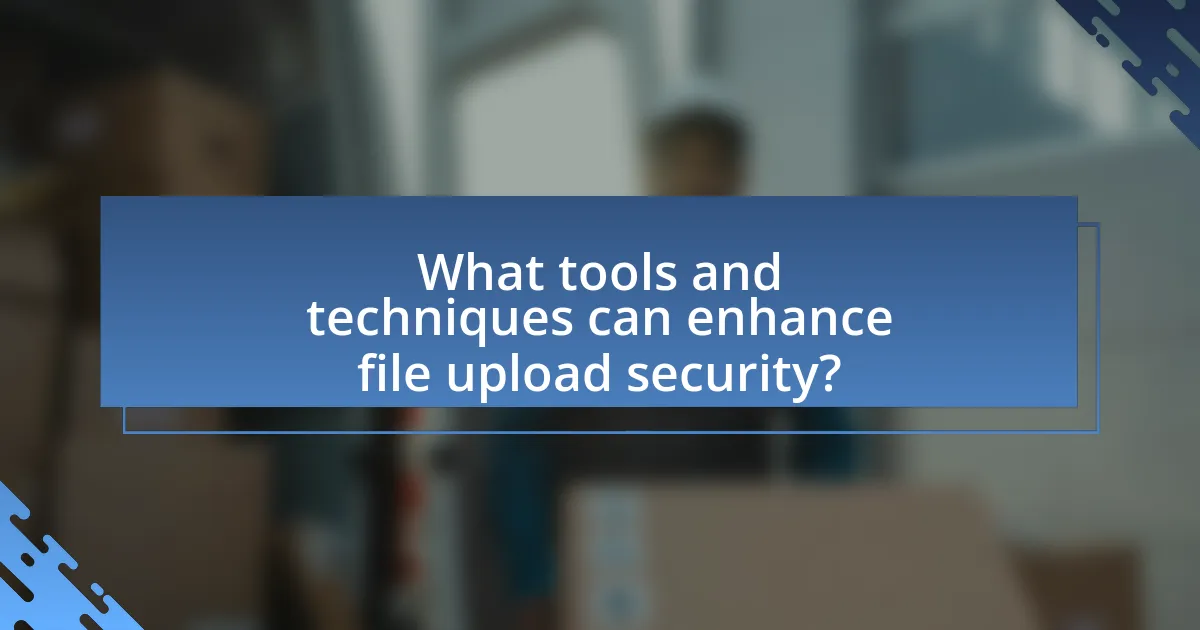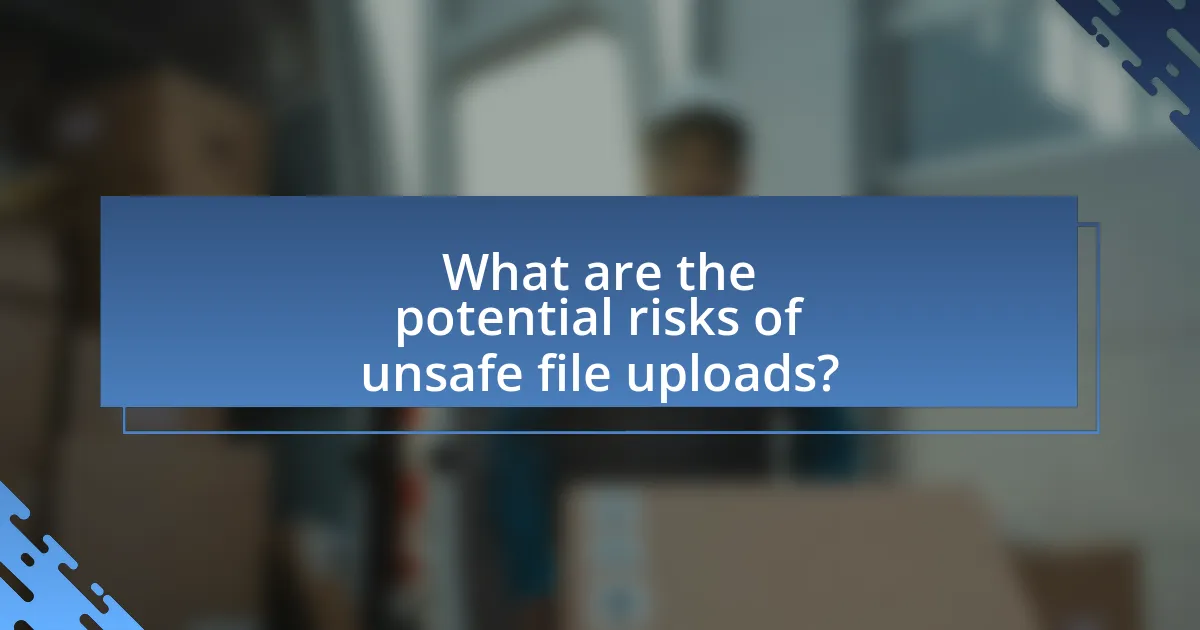The article focuses on tips for safe file uploads on free web hosting platforms, emphasizing the importance of implementing security measures to protect user data. Key considerations include validating file types, enforcing size limits, and ensuring secure storage practices to prevent unauthorized access. It discusses the differences in security protocols among various free hosting services, common vulnerabilities, and the potential risks associated with unsafe file uploads. Additionally, the article outlines best practices for users, including the use of encryption and antivirus scanning, to enhance file upload security and mitigate risks.

What are the key considerations for safe file uploads on free web hosting platforms?
Key considerations for safe file uploads on free web hosting platforms include validating file types, implementing size limits, and ensuring secure storage. Validating file types prevents the upload of potentially harmful files, as only specific formats should be allowed. Implementing size limits protects against denial-of-service attacks by restricting the amount of data that can be uploaded. Secure storage practices, such as using non-public directories and proper permissions, help safeguard uploaded files from unauthorized access. These measures are essential for maintaining the integrity and security of the hosting environment.
How do free web hosting platforms differ in terms of file upload security?
Free web hosting platforms differ in file upload security primarily due to their varying levels of security measures and resource allocation. Some platforms implement basic security protocols, such as file type restrictions and size limits, while others may lack these protections, making them more vulnerable to malicious uploads. For instance, platforms that do not scan uploaded files for malware or do not enforce strict file type restrictions expose users to higher risks of security breaches. Additionally, the lack of encryption during file transfers on certain free hosting services can lead to data interception, further compromising security. These differences highlight the importance of selecting a hosting provider that prioritizes robust security features to safeguard uploaded files.
What common vulnerabilities exist in free web hosting platforms?
Common vulnerabilities in free web hosting platforms include inadequate security measures, lack of regular updates, and shared resources that can lead to cross-site scripting (XSS) and SQL injection attacks. These platforms often do not implement strong encryption protocols, leaving user data exposed. Additionally, many free hosting services do not provide sufficient user authentication, making it easier for attackers to gain unauthorized access. According to a study by the Cybersecurity & Infrastructure Security Agency, shared hosting environments are particularly susceptible to attacks due to their multi-tenant architecture, which can allow one compromised site to affect others on the same server.
How do these vulnerabilities impact user data and security?
Vulnerabilities in file upload mechanisms on free web hosting platforms significantly compromise user data and security by allowing unauthorized access and exploitation of sensitive information. These vulnerabilities can lead to scenarios such as remote code execution, where attackers upload malicious files that execute harmful scripts on the server, thereby gaining control over the server and potentially accessing user data stored on it. For instance, a study by the Open Web Application Security Project (OWASP) highlights that improper validation of file uploads can result in data breaches, with 60% of web applications being susceptible to such attacks. This demonstrates that inadequate security measures in file uploads can directly lead to unauthorized data exposure and loss of user trust.
What best practices should users follow for safe file uploads?
Users should follow several best practices for safe file uploads, including validating file types, scanning for malware, and implementing size limits. Validating file types ensures that only acceptable formats are uploaded, reducing the risk of executing harmful scripts. Scanning files for malware before processing them helps identify and mitigate potential threats, as studies show that 70% of web applications are vulnerable to file upload attacks. Implementing size limits prevents denial-of-service attacks by restricting the amount of data that can be uploaded at once. Additionally, using secure connections (HTTPS) during uploads protects data in transit from interception. These practices collectively enhance security and minimize risks associated with file uploads.
How can users verify the security of a free web hosting platform?
Users can verify the security of a free web hosting platform by checking for SSL certificates, reading user reviews, and examining the platform’s privacy policy. SSL certificates indicate that data transmitted between the user and the server is encrypted, which is crucial for protecting sensitive information. User reviews often provide insights into the platform’s reliability and security practices, while a clear and comprehensive privacy policy outlines how user data is handled and protected. Additionally, users should look for platforms that offer regular security updates and have a history of addressing vulnerabilities promptly.
What types of files should be avoided during uploads?
Files that should be avoided during uploads include executable files, such as .exe, .bat, and .com, as they can contain harmful malware. Additionally, files with scripts like .php, .js, and .html should be avoided because they can execute code on the server, posing security risks. Compressed files, such as .zip and .rar, may also be problematic as they can hide malicious content. According to cybersecurity experts, these file types are commonly associated with security vulnerabilities and should be restricted on free web hosting platforms to protect users and their data.

What tools and techniques can enhance file upload security?
To enhance file upload security, implementing a combination of file type validation, antivirus scanning, and secure storage practices is essential. File type validation ensures that only permitted file formats are uploaded, reducing the risk of malicious files being accepted. Antivirus scanning can detect and block harmful content before it is stored on the server, providing an additional layer of protection. Secure storage practices, such as storing files outside the web root and using access controls, further mitigate the risk of unauthorized access. According to a study by the SANS Institute, 90% of web application vulnerabilities are related to file uploads, highlighting the importance of these techniques in maintaining security.
How can encryption be used to secure file uploads?
Encryption can be used to secure file uploads by converting the file data into a coded format that is unreadable without the appropriate decryption key. This process ensures that even if the file is intercepted during transmission, unauthorized parties cannot access its contents. For instance, using protocols like HTTPS, which incorporates SSL/TLS encryption, protects data in transit by encrypting the connection between the user’s device and the server. Additionally, encrypting files before uploading them adds another layer of security, as the files remain encrypted on the server until they are decrypted by an authorized user. This method is supported by the fact that encryption algorithms, such as AES (Advanced Encryption Standard), are widely recognized for their effectiveness in safeguarding sensitive information.
What encryption methods are most effective for file uploads?
The most effective encryption methods for file uploads are AES (Advanced Encryption Standard) and RSA (Rivest-Shamir-Adleman). AES is widely recognized for its speed and security, utilizing symmetric key encryption to protect data during transmission. It is commonly used in various applications, including secure file storage and transfer, due to its robustness against attacks. RSA, on the other hand, employs asymmetric encryption, which is particularly effective for securely exchanging keys used in symmetric encryption methods like AES. This dual approach enhances security by ensuring that even if data is intercepted, it remains unreadable without the appropriate decryption keys.
How does encryption protect files during the upload process?
Encryption protects files during the upload process by converting the data into a secure format that is unreadable to unauthorized users. This transformation ensures that even if the data is intercepted during transmission, it cannot be accessed or understood without the appropriate decryption key. For instance, protocols like HTTPS utilize encryption to safeguard data as it travels over the internet, significantly reducing the risk of data breaches. According to a study by the Ponemon Institute, organizations that implement encryption experience 50% fewer data breaches compared to those that do not, highlighting the effectiveness of encryption in protecting sensitive information during uploads.
What role do antivirus and malware scanners play in file uploads?
Antivirus and malware scanners play a critical role in file uploads by detecting and preventing the transmission of malicious software. These tools analyze uploaded files for known threats, such as viruses, worms, and trojans, ensuring that harmful content does not compromise the security of the hosting platform or its users. For instance, according to a report by AV-TEST, over 350,000 new malware samples are created daily, highlighting the necessity of these scanners in maintaining a secure environment during file uploads. By integrating antivirus and malware scanning into the upload process, web hosting platforms can significantly reduce the risk of malware infections and protect both their infrastructure and users from potential cyber threats.
How can users implement antivirus checks before uploading files?
Users can implement antivirus checks before uploading files by utilizing reliable antivirus software to scan files locally on their devices. This process involves installing a reputable antivirus program that automatically scans files for malware and other threats before they are uploaded. According to a study by AV-TEST, a leading independent research institute for IT security, effective antivirus solutions can detect over 99% of known malware, significantly reducing the risk of infection during file uploads. Additionally, users can leverage online virus scanning services, such as VirusTotal, which allows users to upload files and check them against multiple antivirus engines for potential threats. This dual approach of local and online scanning ensures a comprehensive check for malicious content before files are shared on free web hosting platforms.
What are the limitations of using antivirus software for file uploads?
Antivirus software has limitations in effectively securing file uploads, primarily due to its reliance on signature-based detection methods. This means that antivirus programs can only identify known threats, leaving them vulnerable to new, unknown malware that has not yet been cataloged. Additionally, antivirus solutions may not scan all file types or may have performance issues that delay the scanning process, allowing malicious files to be uploaded before detection. Furthermore, false positives can occur, leading to legitimate files being flagged as threats, which can disrupt user experience and workflow. These limitations highlight the necessity for additional security measures beyond antivirus software when managing file uploads on free web hosting platforms.

What are the potential risks of unsafe file uploads?
Unsafe file uploads can lead to several significant risks, including malware infections, data breaches, and server compromise. Malware can be embedded in uploaded files, allowing attackers to execute harmful code on the server, which can lead to unauthorized access and data theft. According to a report by the Ponemon Institute, 60% of organizations experienced a data breach due to insecure file uploads. Additionally, attackers can exploit vulnerabilities in the file upload mechanism to gain control over the server, potentially leading to further exploitation of the hosting environment. These risks highlight the importance of implementing strict validation and security measures for file uploads.
What types of attacks can result from insecure file uploads?
Insecure file uploads can lead to several types of attacks, including malware distribution, remote code execution, and cross-site scripting (XSS). Malware distribution occurs when an attacker uploads malicious files that can infect users’ systems. Remote code execution allows attackers to execute arbitrary code on the server by uploading executable files, which can compromise the entire server. Cross-site scripting (XSS) can happen when an attacker uploads files containing scripts that execute in the context of other users’ browsers, potentially stealing sensitive information. These attack vectors highlight the critical need for secure file upload mechanisms to prevent exploitation.
How can malicious files compromise a web hosting platform?
Malicious files can compromise a web hosting platform by exploiting vulnerabilities in the server’s software or configuration. These files may contain malware that can execute unauthorized commands, steal sensitive data, or disrupt services. For instance, a study by the Ponemon Institute found that 60% of organizations experienced a data breach due to compromised files, highlighting the significant risk posed by such threats. Additionally, malicious files can create backdoors, allowing attackers to gain persistent access to the server, further endangering the integrity and security of the hosting environment.
What are the consequences of a successful file upload attack?
A successful file upload attack can lead to severe consequences, including unauthorized access to sensitive data, server compromise, and the distribution of malware. When attackers exploit vulnerabilities in file upload mechanisms, they can upload malicious files that execute harmful scripts or gain control over the server. This can result in data breaches, where confidential information is exposed, and can also facilitate further attacks on users or other systems connected to the compromised server. According to a report by the Ponemon Institute, 60% of small businesses that experience a data breach go out of business within six months, highlighting the critical impact of such attacks.
How can users recover from a security breach related to file uploads?
Users can recover from a security breach related to file uploads by immediately identifying and isolating the affected systems to prevent further unauthorized access. This involves conducting a thorough investigation to determine the extent of the breach, including identifying compromised files and user accounts. Following this, users should restore their systems from clean backups, ensuring that the backups are free from malware or vulnerabilities. Additionally, users must update their security protocols, including changing passwords and implementing stronger access controls. According to a report by the Ponemon Institute, organizations that quickly contain breaches can reduce the average cost of a breach by up to 30%.
What immediate steps should be taken after a breach is detected?
Immediately after a breach is detected, the first step is to contain the breach by isolating affected systems to prevent further unauthorized access. This involves disconnecting compromised devices from the network and disabling any accounts that may have been exploited. Following containment, it is crucial to assess the extent of the breach by identifying what data was accessed or compromised. This assessment should include a thorough investigation of logs and system activity to understand the breach’s scope. Additionally, notifying relevant stakeholders, including affected users and regulatory bodies, is essential to comply with legal obligations and maintain transparency. According to the Ponemon Institute’s 2021 Cost of a Data Breach Report, organizations that contained breaches within 30 days saved an average of $1.2 million compared to those that took longer.
How can users prevent future breaches related to file uploads?
Users can prevent future breaches related to file uploads by implementing strict file validation and sanitization processes. This involves checking file types, sizes, and content before allowing uploads, which reduces the risk of malicious files being executed on the server. According to a study by the SANS Institute, 90% of web application vulnerabilities are related to improper input validation, highlighting the importance of these measures. Additionally, employing security features such as antivirus scanning and using secure protocols like HTTPS can further protect against potential threats during file uploads.
What are the best practices for maintaining ongoing file upload security?
The best practices for maintaining ongoing file upload security include implementing file type restrictions, validating file sizes, and using secure storage solutions. File type restrictions prevent the upload of potentially harmful files by allowing only specific formats, such as images or documents. Validating file sizes ensures that uploads do not exceed predefined limits, reducing the risk of denial-of-service attacks. Secure storage solutions, such as encrypted databases or cloud services, protect uploaded files from unauthorized access. According to the OWASP File Upload Security Cheat Sheet, these measures significantly mitigate risks associated with file uploads, enhancing overall security.
How often should users review their file upload security measures?
Users should review their file upload security measures at least quarterly. Regular reviews help identify vulnerabilities and ensure compliance with evolving security standards. According to the National Institute of Standards and Technology (NIST), frequent assessments are crucial for maintaining robust security protocols, as threats and technologies change rapidly. This proactive approach minimizes the risk of data breaches and enhances overall security posture.
What resources are available for staying updated on file upload security trends?
To stay updated on file upload security trends, professionals can utilize resources such as cybersecurity blogs, industry reports, and online forums. Notable blogs like Krebs on Security and the SANS Internet Storm Center provide timely insights and analysis on emerging threats. Industry reports from organizations like the Ponemon Institute and Verizon’s Data Breach Investigations Report offer statistical data and trends related to file upload vulnerabilities. Additionally, platforms like GitHub and Stack Overflow host discussions among developers and security experts, facilitating knowledge sharing on best practices and recent developments in file upload security.


